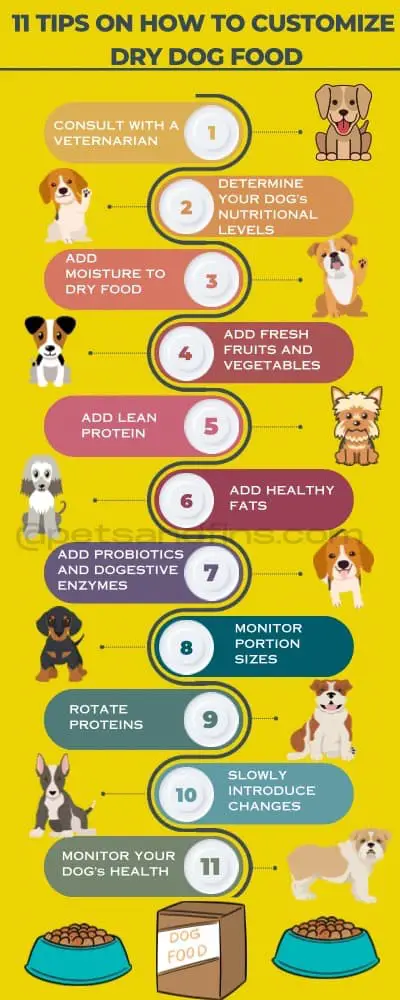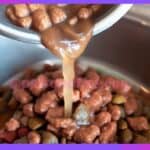Have you ever wondered why some dogs seem to have boundless energy while others prefer lounging on the couch?
Well, the answer might lie in their diet. Just like humans, dogs have different nutritional needs depending on their age and activity level. It is very important to know how to Customize dry dog food for Your Dog’s Age and Energy.
Whether you have a playful puppy, an active adult, or a wise senior, finding the perfect dry dog food that meets their unique requirements is essential for their health and happiness.
In this comprehensive guide, I will explore the factors to consider when choosing dry dog food based on your dog’s age and activity level, helping you make the best decision for your loyal companion.
I will walk you through the process of choosing a dry dog food specifically tailored to your dog’s age and activity level, backed by research and statistics.
My Personal Experience: Understanding My Dog’s Nutritional Needs
When I got my first dog, I had no idea how to properly feed him. I assumed that all dog food was created equal and that as long as he ate something, he would be fine.
However, after doing some research and talking to my vet, I realized that there is a lot more to it than just buying any old bag of kibble.
One thing that really surprised me was learning about the importance of customizing your dog’s food based on their age and energy level.
Just like humans, dogs have different nutritional needs depending on their stage of life and activity level. For example, puppies need more protein and fat in their diet to support their growth and development.
On the other hand, senior dogs may need less protein but more fiber to help with digestion and maintain a healthy weight.
Similarly, if your dog is very active or participates in sports like agility or flyball, they will require more calories than a couch potato pup who spends most of their day napping.
By choosing the right formula for your dog you can ensure they are getting all the nutrients they need to thrive.
Click here for a customised diet plan for your dog 👉🏻👉🏻 https://www.justrightpetfood.com
Dry Dog Food For Puppies: Fueling Growth and Development
1. Quality Protein for Growing Muscles:
During the puppy stage, it’s crucial to provide a dry dog food with high-quality protein sources, such as chicken, beef, or fish. Research has shown that puppies require a higher protein intake than adult dogs to support their rapid growth and development.
2. Adequate Calcium and Phosphorus Levels:
Puppies need an appropriate balance of calcium and phosphorus to promote healthy bone development. According to veterinary research, a calcium-to-phosphorus ratio of 1:1 to 2:1 is recommended for optimal bone health in growing puppies.

Dry Dog Food For Adult Dogs: Maintaining Health and Vitality
1. Moderate Protein Content:
As dogs transition into adulthood, their protein requirements shift. While the exact protein needs may vary depending on the breed and individual dog, research suggests that adult dogs generally thrive on dry dog foods with a protein content of around 18% to 25% to maintain their muscle mass and overall health.
2. Balanced Fat Levels:
Adult dogs require a balance of omega-3 and omega-6 fatty acids for a healthy coat, skin, and overall well-being. Studies have shown that dry dog foods containing a moderate level of fat (around 10% to 15%) and a favorable omega-3 to omega-6 ratio can promote optimal health in adult dogs.

Dry Dog Food For Senior Dogs: Addressing Changing Needs
1. Joint Health Support:
Senior dogs often experience joint issues, such as arthritis, so selecting a dry dog food that includes glucosamine and chondroitin can be beneficial. Research has shown that these ingredients promote joint health and mobility in aging dogs.
2. Reduced Caloric Density:
Senior dogs tend to have lower activity levels and slower metabolisms. It’s important to choose dry dog foods formulated with a reduced calorie content (around 10% to 15% less than regular adult formulas) to prevent weight gain and maintain a healthy weight. Research indicates that overweight senior dogs are more prone to various health issues.
Click here for detailed info on 👉🏻👉🏻https://petsandfins.com/13-easy-tips-to-buy-best-dog-food-for-senior-dogs/

Active and Working Dogs: Providing Extra Energy
1. Increased Protein and Fat Levels:
For highly active or working dogs, selecting a dry dog food with higher protein and fat content is crucial. Research suggests that active dogs benefit from dry dog foods containing at least 30% protein and 20% fat to provide the extra energy needed to sustain their high activity levels.
2. Complex Carbohydrates for Sustained Energy:
In addition to protein and fat, active dogs benefit from complex carbohydrates like sweet potatoes or brown rice. These carbohydrates release energy slowly, ensuring a steady supply throughout their demanding activities. Research has shown that the inclusion of complex carbohydrates in the diet can help active dogs maintain their energy levels and overall performance.

Special Considerations: Allergies and Sensitivities
1. Limited Ingredient Diets:
If your dog suffers from food allergies or sensitivities, consider a dry dog food with a limited ingredient list. These formulas typically contain a single source of protein and carbohydrate, minimizing the risk of triggering allergies. Research suggests that limited ingredient diets can be effective in managing food sensitivities in dogs.
2. Grain-Free Options:
While grain-free diets have gained popularity, it’s important to note that recent research suggests a possible link between grain-free diets and a higher risk of canine dilated cardiomyopathy (CDCM). Consult with your veterinarian before opting for a grain-free diet, especially if your dog does not have specific grain allergies.
Reading and Understanding the Labels
1. Ingredient List:
Carefully review the ingredient list on dry dog food packaging. Look for whole, recognizable ingredients at the top of the list, indicating higher quality. Avoid foods with fillers, by-products, and artificial additives. Research has shown that diets containing high-quality ingredients have a positive impact on dogs’ overall health and well-being.
2. Guaranteed Analysis:
The guaranteed analysis section provides essential information about the nutrient content of the dry dog food. Pay attention to the protein, fat, fiber, and moisture levels to ensure they align with your dog’s specific needs. Research suggests that meeting the nutritional requirements through the guaranteed analysis can contribute to optimal health in dogs.
Click here to know more about 👉🏻👉🏻https://petsandfins.com/15-reasons-why-you-should-read-dry-dog-food-labels/

Consulting Your Veterinarian
1. Individual Health Considerations:
Every dog is unique, and some may have specific health concerns that require special dietary considerations. Consult with your veterinarian to address any specific health conditions, such as allergies, sensitivities, or digestive issues. Your veterinarian can provide personalized advice and recommend appropriate dry dog foods based on your dog’s individual needs.
2. Breed and Size Guidelines:
Certain dog breeds or sizes may have different nutritional requirements. Your veterinarian can provide breed-specific or size-specific guidelines to help you choose the most suitable dry dog food for your furry friend. Research has shown that breed and size play a role in determining the optimal nutrient composition for dogs.
Transitioning to a New Dry Dog Food
1. Gradual Transition:
When introducing a new dry dog food, it’s important to transition gradually to avoid digestive upset. Start by mixing a small portion of the new food with your dog’s current food, gradually increasing the proportion over 7-10 days. Research indicates that a gradual transition helps dogs adapt to the new food and minimizes gastrointestinal issues.
2. Monitoring Your Dog’s Response:
Observe your dog’s response to the new dry dog food. Look for signs of improved energy, coat quality, digestion, and overall well-being. If any negative changes occur, consult your veterinarian for guidance. Regular monitoring of your dog’s response to the new food helps ensure their nutritional needs are being met.
Click here to know about 👉🏻👉🏻https://petsandfins.com/how-to-shift-your-dog-to-a-new-dry-dog-food/
Regular Evaluation and Adjustments
1. Regular Health Check-ups:
As your dog ages or experiences changes in activity levels, it’s crucial to schedule regular check-ups with your veterinarian. They can assess your dog’s health, address any concerns, and recommend adjustments to their diet if necessary. Regular health check-ups play a vital role in maintaining your dog’s overall well-being.
2. Stay Informed:
Stay updated on the latest research and recommendations regarding dog nutrition. As new studies emerge, be open to adjusting your dog’s diet accordingly to ensure they receive the best care possible. Staying informed allows you to make informed decisions about your dog’s diet and ensures that they receive optimal nutrition throughout their life.
11 General Tips On How to Customize dry dog food for Your Dog

1.Consult with a Veterinarian:
Before making any changes to your dog’s diet, it is crucial to consult with a veterinarian. They can assess your dog’s health, specific dietary needs, and provide personalized recommendations to guide you in customizing their dry food.
2.Determine Your Dog’s Nutritional Requirements:
Understanding your dog’s nutritional needs is essential. Factors such as age, breed, size, activity level, and any specific health conditions will influence their dietary requirements. Your veterinarian can help you determine the right balance of nutrients for your dog.
3.Add Moisture:
Dry dog food can be somewhat dehydrating. Consider adding moisture to your dog’s kibble to make it more appealing and easier to digest. You can mix in a small amount of warm water, bone broth, or low-sodium chicken or beef broth.
4.Introduce Fresh Fruits and Vegetables:
Incorporating fresh fruits and vegetables into your dog’s diet can provide additional vitamins, minerals, and fiber. Some safe options include carrots, green beans, apples, and blueberries. Always research which fruits and vegetables are safe for dogs and introduce them gradually.
5.Include Lean Protein:
To enhance the protein content of your dog’s dry food, consider adding lean sources such as boiled chicken, turkey, or beef. Cooked eggs and cottage cheese can also be great options. Ensure that the proteins are plain and free from seasoning or added ingredients that may be harmful to dogs.
6.Healthy Fats:
Adding healthy fats to your dog’s diet can contribute to their overall well-being. Omega-3 fatty acids, found in fish oil or flaxseed oil, are beneficial for their coat, skin, and joint health. Consult your veterinarian to determine the appropriate dosage.
7.Probiotics and Digestive Enzymes:
Supplementing your dog’s diet with probiotics and digestive enzymes can support their digestive health. These supplements can help improve nutrient absorption and promote a healthy gut flora. Discuss with your veterinarian to find suitable options and appropriate dosages.
8.Monitor Portion Sizes:
Ensure you are providing the right amount of food for your dog’s size and activity level. Customizing their diet doesn’t mean overfeeding. Follow the feeding guidelines provided on the packaging and make adjustments based on your veterinarian’s recommendations.
9.Rotate Proteins:
To add variety to your dog’s meals, consider rotating different protein sources. Switching between proteins such as chicken, beef, fish, or lamb can prevent food sensitivities and provide a wider range of essential nutrients.
10.Slowly Introduce Changes:
When customizing your dog’s diet, introduce changes gradually to prevent digestive upset. Sudden dietary changes can cause stomach upset and diarrhea. Slowly incorporate new ingredients over a span of a week or two.
11.Regularly Monitor Your Dog’s Health:
Keep a close eye on your dog’s overall health, energy levels, coat condition, and stool quality. Regular monitoring allows you to gauge the effectiveness of the customized diet and make adjustments if necessary. Contact your veterinarian if you notice any significant changes or concerns.
Related Questions
How can I make dry dog food more interesting?

Here are some ways to make dry dog food more interesting:
1. Add wet food: Mixing in a small amount of wet dog food can add flavor and moisture to dry kibble. This can be especially helpful for dogs who have trouble chewing or those who need extra hydration.
2. Use broth: Adding low-sodium chicken or beef broth to dry kibble can give it a boost of flavor without adding too many calories. Be sure to choose a broth that does not contain any harmful ingredients like onion or garlic.
3. Add fruits and vegetables: Many fruits and vegetables are safe for dogs and can provide added nutrition and flavor to their meals. Some examples include carrots, green beans, blueberries, and apples.
4. Use puzzle feeders: Puzzle feeders are toys that require your dog to work for their food by solving puzzles or manipulating objects. This can make mealtime more engaging and mentally stimulating for your pup.
5. Rotate flavors: Just like humans, dogs can get bored with eating the same thing every day. Consider rotating between different flavors of dry dog food to keep things interesting.
6. Make homemade treats: Homemade treats made with natural ingredients like peanut butter, pumpkin puree, or sweet potato can be a tasty addition to your dog’s diet.
In conclusion, there are many ways to make dry dog food more interesting for our furry friends while still providing them with the nutrition they need. By incorporating these tips into your routine, you’ll be sure to keep your pup happy and healthy at mealtime!
Click here for an in-depth article on how to make your dry dog food more interesting. 👉🏻👉🏻 https://petsandfins.com/25-easy-tips-to-make-your-dog-eat-dry-dog-food/
Can you create your own dog food?
While it is possible to make homemade dog food, there are several factors to consider before embarking on this endeavor.
First and foremost, it is important to understand that dogs have specific nutritional needs that must be met in order for them to thrive. These needs include a balance of protein, carbohydrates, fats, vitamins, and minerals.
Creating a homemade dog food recipe requires careful consideration of these requirements and ensuring that the ingredients used provide adequate nutrition.
Additionally, creating your own dog food can be time-consuming and expensive. It may require purchasing specialty ingredients or supplements in order to meet your dog’s nutritional needs.
It is also important to note that not all human foods are safe for dogs – some common foods like chocolate or onions can be toxic.
If you do decide to create your own dog food at home, it is recommended that you consult with a veterinarian or veterinary nutritionist first.
They can help you determine your dog’s specific nutritional needs based on factors such as age, breed, weight, and activity level.
When creating a homemade dog food recipe, it is important to use high-quality ingredients and ensure that they are properly cooked or prepared.
This includes using lean meats like chicken or turkey as the primary protein source and incorporating healthy carbohydrates like sweet potatoes or brown rice.
It may also be necessary to supplement your homemade dog food with additional vitamins and minerals in order to ensure that your pup is getting everything they need nutritionally. This could include adding fish oil for omega-3 fatty acids or calcium supplements for bone health.
One potential benefit of creating your own dog food is having more control over what goes into your pup’s diet. This can be especially important for dogs with food allergies or sensitivities, as you can tailor the recipe to avoid any problematic ingredients.
However, it is important to note that creating your own dog food does come with some risks. If the recipe is not properly balanced or prepared, it could lead to nutritional deficiencies or even illness in your dog.
It is also important to ensure that any supplements or additional ingredients are safe for dogs and given in appropriate amounts.
In conclusion, while it is possible to create your own dog food at home, it requires careful consideration of your dog’s nutritional needs and proper preparation of high-quality ingredients.
Consulting with a veterinarian or veterinary nutritionist can help ensure that your homemade dog food recipe provides adequate nutrition for your furry friend.
While there may be benefits to creating your own dog food, it is important to weigh the potential risks and consider whether this option is right for you and your pup.
Key Takeaways
Choosing the right dry dog food based on your dog’s age and activity level is an essential responsibility for a pet owner.
By understanding your dog’s specific nutritional needs and considering factors such as age, activity level, and any special requirements or sensitivities, you can make an informed decision.
Remember to consult with your veterinarian, stay informed about the latest research, and regularly evaluate and adjust your dog’s diet to ensure their optimal health and well-being for years to come. Your furry friend will thank you for providing them with nutritious and delicious dry dog food that suits their individual needs.

